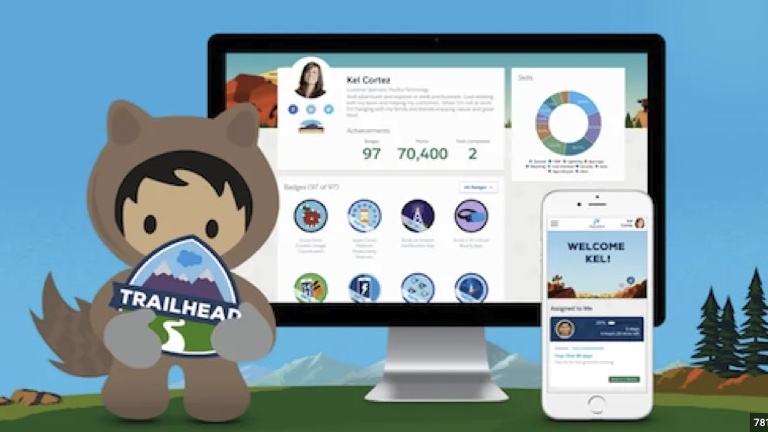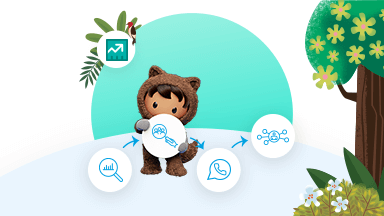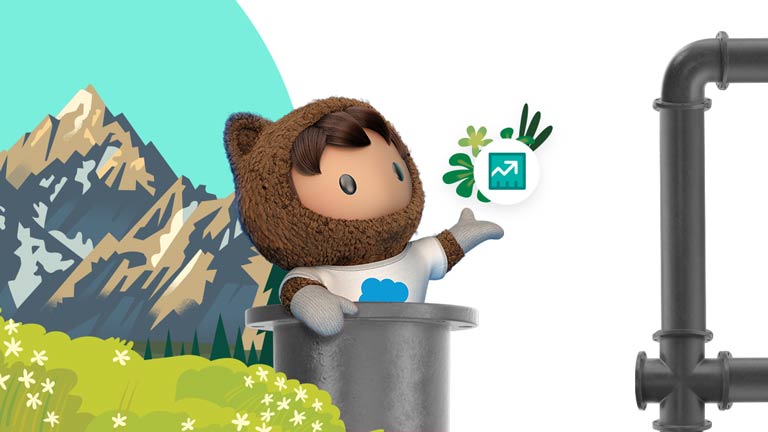How to Build A Sales Process That Lands Deals Every Time
Learn how to successfully land a sale, from prospecting to closing the deal.
Business growth expert Tiffani Bova said it best: “How you sell matters. What your process is matters.”
Think of your sales process like a map. It shows you how to get from point A in the sale (finding your prospect) to point Z (closing the deal), highlighting necessary steps along the way. Without it, you get lost, fumble, or stall out.
The best sales processes make selling easy by helping you optimize sales conversations, delivering the right value at the right time. As these conversations unfold, you learn more about your prospects and how you can make their jobs — and lives — easier with your solutions.
Sound complicated? Don't worry, we'll unpack it for you.
Here's what we’ll cover:
- What is the sales process?
- Why is a sales process important?
- What are the most important sales process steps?
- Sales process example
- What are common sales process mistakes and how do you avoid them?
- How do you continually improve your sales process?
- What’s the difference between a sales process and a sales methodology?
What is the sales process?

Why is a sales process important?
Having a documented sales process helps you know when and how to move a deal through the stages of a sales pipeline, increasing the chances of closing. Without this process, you might push your product before the prospect is ready for a solution, or wait too long for fear of being pushy or aggressive. In both cases, the prospect is likely to look elsewhere.
When you have a clear sales process, you know how to deliver tailored solutions and value to the prospect at the right time, keeping the sales conversation going until they are ready to buy.
What are the most important sales process steps?
1. Build product knowledge.
Today, clients expect sales reps to know every detail about the product they’re selling. This streamlines communication and accelerates the sales cycle, while giving reps the knowledge and confidence they need to handle objections.
The best way to learn about your products is by reviewing product demos, press releases, and documentation, and then using this knowledge in your sales conversations. Ask developers and product managers questions about functionality, use cases, and potential pitfalls. Take notes highlighting the standout features and the problems they solve for customers.
2. Research your ideal prospect.

If you don’t have access to a buyer persona, spend time researching your target market. Here are key questions to guide your research:
- What buyer data do I already have that can help me outline the ideal prospect?
- What unique needs does my product or service address, and who has these needs?
- What are the characteristics of prospects targeted by my competitors?
- Where do my ideal prospects live, and how do they engage with businesses like mine?
There are many tools you can use to gather this information, but it’s best to start by collecting insights from your company’s CRM. If it has built-in analytics, you can see where past sales came from and the basic demographic information or business details of buyers. You can also collect information on buying habits, including the average purchase frequency of buyers, which products are most popular, and average revenue per sale.
Then, add institutional knowledge to any CRM data you collect. Talk to tenured sales reps and managers about the customers they’ve worked with and get intel on their behaviors, communication patterns, needs, and pain points.
To round out your research, use a generative AI tool to learn about your competition’s marketing, pricing, service, and sales tactics. What strategies bring in the most business for your competitors and how can you make use of them to find prospects?
Learn sales process best practices from other Salesblazers
3. Begin prospecting and lead generation.
Prospecting is the process of finding individuals or businesses that are good candidates for a sale.
Start by asking fellow reps or industry connections for referrals or looking at online portals and communities for viable prospects. Search for product or industry keywords on broad-scope engagement platforms like LinkedIn, then move to trusted, niche sites that prospects commonly use for product research.
If you need additional help, search Google using keywords related to your product or business and look for relevant sites where potential prospects are engaging via comments or forums. This also allows you to collect information about their needs and pain points. When you identify a prospect you’d like to pursue, find them on LinkedIn or ZoomInfo, and collect any available contact details.
You can supplement these efforts with inbound lead-generation campaigns. While traditional prospecting is outbound, requiring outreach to those who might be interested in your product, lead generation campaigns pull interested contacts into your pipeline via display ads, paid search ads, and social media ads. Work with your marketing teams to create these campaigns and target audiences that match your buyer persona.
Lastly, use your CRM and AI tools to streamline the prospecting process. You can use automated workflows and intelligent digital assistants to conduct research across the web and score prospects to see which are the most likely to convert.
4. Qualify prospects.
Not all prospects are created equal. Before you can make a pitch, you need to verify that your product is a good match for the prospects you’ve identified. This requires a qualification call.
The qualification call collects basic information about need, budget, timeline, and authority that allows you to identify prospects most likely to buy. During the call, you should focus on the following key questions:
- What does the prospect need and does your product provide the right solution?
- Do they plan to make a product purchase soon? If so, when?
- How much do they have to spend on your product?
- Who has the authority to make the purchase and do you have their contact information?
Cynthia Barnes, founder of the National Association of Women Sales Professionals (NAWSP), recommends framing this as a checklist that can guide conversation rather than a list of very direct questions. “Don’t make it feel like an interrogation,” she said. “Treat your prospect like you would your best friend.”
Once you’ve qualified a prospect in an initial call, set up another meeting to further understand what they need and how you might meet that need (known as a discovery call). Keep in mind that 95% of buyers make purchase decisions based on emotion, so understanding a prospect’s emotional levers is key.
Below are some probing questions that can guide this discussion:
- What pain points or problems do you have right now?
- How have these problems affected your day-to-day work or life?
- What’s preventing you from finding lasting solutions?
- If you implemented solutions that didn’t work, why didn’t they work?
- What would an ideal solution look like?
Remember this is not an inquisition. Keep the conversation free-flowing and natural. Once you have answers to the questions above, you can move forward with identifying products that will solve their problems. If a prospect doesn’t identify a problem that can be solved with your product, remove them from your list.

5. Lead a sales call.
It’s finally time to schedule a sales call and present your pitch. This is an opportunity to present your product as a solution to your prospect’s problems.
Tailor your pitch to your prospect and discuss solutions, not product features. This customized approach makes the prospect feel valued, rather than being sold to.
Write out potential objections and draft responses to them ahead of your presentation. Be careful not to go into full defense mode when you hear objections. Ask for additional details and context to ensure you understand the root of the problem.
Barnes suggests combining your prepared responses with the “feel, felt, found” formula: “I understand how you feel. Others have felt the same way about [our product]. However, they have found that [our product] is worth the money/time/energy because [reason].” (Check out our objection-handling-tips for more guidance.)
If you need some coaching guidance, be sure to bring in AI-powered coaching tools that can analyze your conversations and provide feedback or guidance — ideally in real time.
Once you’ve finished your presentation, suggest a timeline for the next steps. This should include any follow-up calls and a proposed deadline for the sale to close.

PRO TIP
6. Follow up and close the deal.
Immediately after the sales call, follow up with the prospect, summarizing your conversation and reiterating next steps. If additional information was requested, send this with your follow-up message.
The prospect may respond with additional questions about your product. Answer these right away and urge them to make a purchase decision by the date specified during the sales call. You can make this easy by sending a PDF contract with an electronic signature (e-sign) field.
7. Nurture the relationship and upsell.
If all goes well, your prospect is now a customer. Congratulations! But the sales process isn’t over yet. Satisfied customers provide a huge opportunity for cross-selling and upselling. As Alex Turnbull, CEO and Founder of Groove, noted, “Upselling isn’t just a sales tactic — it’s a customer happiness tactic that can help you build deeper relationships with customers by delivering more value.”
Barnes’ formula of threes makes this easy:

Check in to make sure the client is satisfied.

Check in to see if the client has any questions or product issues.

Check in to confirm satisfaction with the product and service, then ask for a referral.
“Don’t forget the human side of sales. People buy from those they know, like, and trust.”
“Don’t forget the human side of sales. People buy from those they know, like, and trust.”
Sales process example
To see the sales process in action, let’s take a look at how home manufacturer HomesRUs finds customers and closes deals efficiently.
Background: Construction company HomesRUs launched in 2020, with a simple goal: to sell affordable homes in the Chicagoland area to young families. Their homes typically take three months to build, and early estimates show they will cost between $200,000 and $500,000.
With construction on their first homes underway, HomesRUs onboards an eager young rep, Emily, to start selling. Unfortunately, there’s no sales process in place and Emily doesn’t know much about the company. Emily has experience selling, however, so starts building out the process she needs to land her first sales.
Company and product research: On her first day, Emily meets with the construction lead and the CFO. She asks specific questions about how the homes are designed, what materials are used in the building process, where the homes will be built, and how the company determines initial pricing. She learns that one of the company’s key differentiators is its American-made materials.
Prospect research: With a better understanding of the company and its product, Emily then sits down to map out what she knows about her ideal prospect. She wants to target young families, and given mortgage rates, aims for those with a household income of about $100,000. She also reaches out to a couple of local real estate agents to ask about their client base — specifically, what they look for in a new home, what their challenges are, and where they typically look for homes.
Prospecting: Emily now knows enough to start looking for prospects. She joins some local real estate community groups, real estate-related Reddit threads, and LinkedIn groups used by her target buyer. She also plans a few real estate “get to know you” events at local clothing and home goods stores where she knows her ideal buyer likes to shop.
Qualification and discovery: With a few prospects in hand from searches and events, Emily reaches out. She starts by offering free packets of information on the local real estate market and the home-buying process — must-have information for new homeowners. She then asks for a quick call to talk about what her prospects are looking for and how she can help. She learns some of them are targeting homes at a much lower price point, so removes them from her prospecting list.
Sales call: For her best-fit prospects, Emily suggests meeting in person to tour one of the model homes and talk through features, price, availability, and timing. To make the home more alluring, she makes sure it’s staged with freshly baked cookies in the kitchen (chocolate chip, of course). After several successful walk-throughs, only one of her prospects is keen to move ahead right away. The others have some concerns about price and ask for more time to think about the opportunity.
Follow up: A day after her home tours, Emily follows up with each one of her best-fit prospects to let them know what the next steps are, including home inspection and the loan application. For those who were on the fence about a purchase, she lets them know she’ll follow up in a few months to see how they feel about moving ahead.
Close: Lucky for Emily, her most engaged prospect agrees to buy. Yay! She sets up the home inspection and helps the customer file all of the paperwork for the loan and purchase. As a thank you, she sends the buyer a gift basket filled with goodies for their new home.
Nurture: Emily sends the new homeowners an email a few weeks after the sale to check in. She makes sure the home meets their expectations and they haven’t seen any design or structural issues. She also checks to ensure all the final steps of the sale — loan paperwork, and so on — were wrapped up without issue. When she hears how happy the customer is, she asks for a referral, offering a $1,000 incentive for every new customer they bring to HomesRUs.
Not every sales process will look the one Emily and HomesRUs use, of course, but the basic flow is the same. Make sure you have ample information to find the right buyer, then deliver value throughout the process to make the close easy.
What are common sales process mistakes and how do you avoid them?
1. Poor preparation.
Research is key to successful sales. When done correctly, it allows you to speak confidently about what you’re selling and what problems it solves. When done poorly — or not at all — prospects lose confidence in your product and business.
Take the time to understand both what you’re selling and your target audience before you ever make a sales call. Not only will you avoid embarrassing fumbles, but you’ll be able to address unique problems and value propositions in your prospect communications.
2. No needs analysis (discovery) call.
Many reps think a qualifying call is sufficient background to pick out the best prospects on their list. In most cases, however, this call is very high level and doesn’t adequately paint the picture of a prospect’s needs.
Barnes calls this out as a common issue with new reps and recommends a separate call for discovery. “Take the time to hear about [your prospects’] pain points in-depth. Only when you fully understand these pain points can you offer a solution.”
3. Making a sales pitch before qualifying leads.
Many eager salespeople are so focused on quotas and commissions they forget the qualifying and discovery calls and launch straight into the sales pitch. The result is often a dead end — the unvetted prospect has little interest, insufficient budget, or is not empowered to make buying decisions.
Take the time to learn about your prospect’s alignment with your products before a sales call and you’ll dramatically increase your chances of closing a deal.
4. Highlighting product features, not value.
It’s common for reps to lead a sales call touting product features. The problem is, prospects aren’t looking for features. They’re looking for solutions and value.
As Executive Sales Coach Jay Abraham advises, “Sell the benefit, not the company or the product. People buy results, not features.”
5. Being unempathetic.
Laser-focused on closing deals, reps can come across as pushy. Nobody wants to make a buying decision under pressure.
Don’t think of your prospect as a potential client. Think of them as a friend. Listen to their problems with empathy. It builds trust and loyalty, which make a purchase decision easier.
6. Talking too much.
Constant talking is often cited as the number-one mistake salespeople make. It alienates prospects and scuttles once-promising deals. In fact, many studies have demonstrated the negative impact of talking more than listening during sales calls. The takeaway is the same: Reps who consistently close deals listen more than they talk.
The golden ratio is hard to pin down, but many experts recommend a 60/40 split in favor of listening. This gives reps enough time to share value-based insights while making sure the prospect is heard.
7. Being unprepared for objections.
There are countless potential objections to a sale: cost, bad timing, insufficient need, lack of product functionality, and so on. While these will vary depending on the prospect, they’re often easy to anticipate. Unfortunately, many reps struggle to close sales due to common objections they don’t know how to overcome.
The best solution is to map out all likely prospect objections before you make your pitch. Then, use Barnes’ “3 Fs Formula” along with your product and prospect research to prepare empathetic and impactful responses.
8. Making sales calls too long.
In the era of virtual selling, sales leader and consultant Larry Long Jr. notes reps struggle to keep calls short enough to retain prospects’ attention. The result, he says, is poor engagement and waning product interest.
Fortunately, the solution is easy: Keep your calls (in-person or virtual) to 30 minutes max. This forces you to avoid tangents and focus on sales-critical information.
9. Waiting too long to follow up.
“The longer you wait to follow up with a prospect after a sales call,” cautions Barnes, “the colder the sale becomes.” Lazy or distracted reps sometimes leave days between the sales call and their follow-up email. By that point, the interest generated in the product has faded, making the close far more difficult.
Avoid this pitfall by sending follow-up messages immediately after your sales call. And keep following up — “until they tell you to stop,” Barnes advises.
“Whatever your methodology, make sure you align it with the sales process in your system of record (CRM). If you don’t, it will never be adopted.”
“Whatever your methodology, make sure you align it with the sales process in your system of record (CRM). If you don’t, it will never be adopted.”
How do you continually improve your sales process?
Building a sales process isn’t a “one and done” effort. According to longtime consultant and sales coach Scott Leese, you should revisit your process every six months to ensure there are no bottlenecks, inefficiencies, or dated guidance. A lot of this work is the responsibility of sales managers or sales operations leads, but reps should feel empowered to provide feedback on goal metrics, target buyer personas, their tech stack, and possible process bottlenecks.
Here’s how to get started:
1. Examine your performance against goal metrics.
Several steps in the sales process have performance metrics associated with them to ensure you keep deals flowing and, ultimately, hit sales goals. The most commonly tracked ones are: the number of prospects added to each rep’s pipeline in a given period, the number of sales calls made, the number of deals won, and, to a lesser extent, the number of upsells and cross-sells.
During your biannual review, identify how your performance compares to goal metrics. If there are certain areas where you’re falling behind, take a close look at the messaging and process in that area. Determine potential areas for improvement by asking:
- Is the product messaging I’m using dated or inaccurate?
- Does my outreach seem out of touch?
- Am I taking too long to complete tasks?
- Are there obstacles to completing tasks in this step?
When you have identified possible areas for improvement, flag them with your manager or sales ops lead for review. Make sure you map out a plan for updating your sales process to address problem areas, with next steps and action items clearly outlined. Aim to complete these action items one to two weeks after your review.
2. Review your target buyer persona.
Your ideal prospect will likely change as the market and your products change. Pull up your buyer persona (created in step 2) and make sure that it makes sense for your current prospecting efforts. You can use the questions you asked when creating your buyer persona to see if it still fits:
- What unique needs does my product or service address, and who has these needs?
- What are the characteristics and challenges of prospects targeted by my competitors?
- Where do my ideal prospects live and how do they engage with businesses like mine?
If your answers don’t align with the buyer persona as it stands, bring it to the attention of your sales ops team or sales leader and ask them to consider making updates.
3. Re-evaluate your tech stack.
According to the State of Sales Report, almost two-thirds of sales reps report being overwhelmed by too many tools. This can lead to a lot of time wasted on redundant data entry, and increases the chances for human error.
To avoid these pitfalls, audit your sales tools. Do they require a lot of data entry that takes you away from critical sales conversations? Are there some you would consider unnecessary or unhelpful? (Here’s a helpful guide for completing a comprehensive audit.)
It’s also important to examine naming conventions and language used in your technology. When systems are set up piecemeal or by different teams, there can be language differences that cause confusion. Is there a consistent taxonomy used across all reps and pipelines for stages and deal records in your CRM, or is naming different for different team members? Are you confused by labels, tags, or instructions?
If you’re seeing productivity obstacles here, surface them with your manager or sales ops team. Wherever possible, use concrete examples to show how these issues are negatively impacting your sales.
4. Identify possible process bottlenecks.
Part of the benefit of sales process reviews is identifying areas to improve overall efficiency, Leese says. Don’t be afraid to dig into the roots of your process to see what needs to be uprooted. It’s possible that long-standing steps are actually dragging down performance.
Start by looking at the numbers. Pull up your CRM analytics tool to look at three key metrics, which gauge prospect engagement in each sales process step: average time in each step, average number of prospects in one step at the same time, and overall win rate.
First question to ask: How do these metrics compare to the previous six months? If performance is up, you’re making strides toward greater efficiency. If performance is down, look for the root cause by asking:
- Do you have clear exit criteria in place for each step of the sales process?
- Where are prospects getting stuck?
- Based on where prospects stall in the sales process, are there unnecessary steps?
- Is your sales process missing a critical step, like discovery or qualification?
- Do you need additional or better resources to successfully complete each step?
When you have a better sense of problem areas in your sales process, you can bring them to the attention of your sales operations lead. As always, bring evidence to support your conclusion and recommend a potential change to address the problems you uncovered.
5. Ask for enablement updates.
What’s the difference between a sales process and a sales methodology?
Popular sales methodologies include:

Challenger Selling

Trigger or signal-based selling

Value-based selling

360-degree selling
More Resources

Report
State of Sales Report

Demo
See how AI-powered Sales GPT makes selling easy













